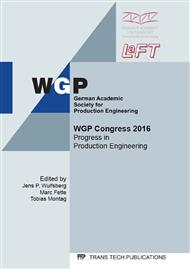p.255
p.264
p.272
p.280
p.288
p.296
p.304
p.312
p.320
Modelling the Stress Concentration in CFRP at Notches with a Thermally Influenced Cut Edge
Abstract:
The use of higher laser powers in laser cutting of CFRP results in both an increase of productivity and in a growth of the heat affected zone at the cut edge. This thermal damage was related to a loss of the static strength due to the reduce load bearing cross section in various studies. In contrast, the thermal damage caused an increase of the average number of load cycles and to a significant reduction of the deviation among the repetitions of each parameter during dynamic open hole tensile testing in recent studies. To explain this positive influence of laser cutting on the fatigue behaviour of CFRP, an analytical model of the load concentration in a plate with a circular notch could be adapted and modified. The orthotropic property of the material is considered in the model. The static strength of thermally treated CFRP was determined in experiments and applied to the model. By inserting the measured temperature-dependent values of the Young´s modulus, the critical tension at the notch could be determined related to the dimensions of the heat affected zone.
Info:
Periodical:
Pages:
288-295
Citation:
Online since:
August 2016
Authors:
Keywords:
Price:
Сopyright:
© 2016 Trans Tech Publications Ltd. All Rights Reserved
Share:
Citation:


